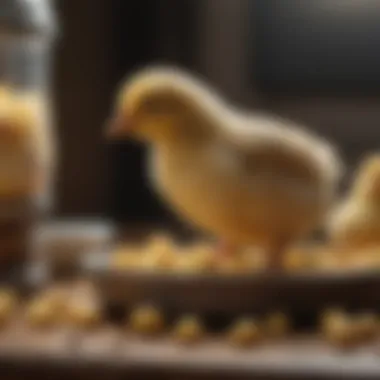Essential Care Guide for Day-Old Chicks: Best Practices


Intro
Day-old chicks require special attention and care for their healthy development. Understanding their unique needs is crucial for any poultry keeper, whether beginner or experienced. This guide provides vital information on housing, nutrition, health monitoring, and general management of day-old chicks. Implementing these strategies can enhance survival rates and promote optimal growth.
Grooming Techniques
Grooming plays a significant role in maintaining the overall well-being of chicks. While young birds may not require elaborate grooming, basic techniques ensure they remain clean and healthy.
Basic Grooming Tools
To effectively groom day-old chicks, certain tools can be beneficial:
- Soft Brushes: These are gentle and can remove dust or debris from feathers.
- Cotton Balls or Swabs: Useful for cleaning around the eyes and beak.
- Mild Soap: In cases of severe soil or dirt; however, ensure it is safe for poultry.
- Nail Clippers: To maintain proper nail length if necessary, although this is less common with such young chicks.
Step-by-Step Grooming Guides
Grooming day-old chicks can be simple and straightforward. Here’s a basic guide:
- Observe: Regularly check for any signs of dirt or debris.
- Gentle Cleaning: Use a soft brush or cotton ball to clean feathers if needed. Be gentle and avoid stressing the chick.
- Nail Maintenance: If claws appear long, carefully trim with nail clippers. Safety is priority, so do not cut too close to the quick.
- Monitor Health: During grooming, watch for any unusual signs, such as lethargy or swelling.
Breed-Specific Grooming Needs
Different breeds may exhibit varied grooming needs. For example, some feathered breeds might accumulate dirt more than others. Researching specific species can provide further insight into tailored grooming practices, ensuring optimal health.
Health and Wellness
Proper health management sets the foundation for growth and productivity.
Nutrition and Diet Tips
Nutrition is paramount for day-old chicks. Their diet should consist of:
- Starter Feed: This is crucial for growth and development, providing balanced protein and nutrients.
- Fresh Water: Always ensure access to clean water to promote hydration.
- Grit: Include grit if chicks are eating anything other than commercial feed. This aids digestion.
Common Health Issues and Solutions
Young chicks may encounter several health challenges:
- Pasty Vent: This condition occurs when droppings stick to the vent area. Monitor closely and clean gently with warm water.
- Coccidiosis: A serious intestinal disease. If chicks show signs of diarrhea or lethargy, consult a veterinarian immediately.
Importance of Regular Check-Ups
Regular health monitoring is crucial. Establish a routine for checking each chick. Look for:
- Signs of distress or illness.
- Proper feather development.
- Behavior changes.
Training and Behavior
Understanding and working with the natural behavior of chicks will enhance their management.
Basic Training Commands
Training day-old chicks may seem daunting. Start with simple commands like:
- Come: Reward them with feed or treats.
- Stop: Use a gentle hand motion and vocal command.
Understanding Common Behavioral Issues
Chicks, when stressed, might exhibit certain behaviors. Here are some signs:
- Pecking: Sometimes occurs due to boredom. Increasing space can help.
- Crying or Chirping Excessively: Often a sign of discomfort.
Techniques for Effective Training
Establish a calm environment. Positive reinforcement works best. Use treats to reward desirable behaviors. Remember that consistency, patience, and understanding lead to progress.
Community Insights
Engaging with others can provide invaluable support and insight.
User-Submitted Tips and Tricks


Many poultry keepers share their experiences online. Exploring forums and groups can provide practical advice based on real-world experiences.
Real-Life Grooming Experiences
Discussing grooming and management experiences with the community can uncover successful methods and warnings about potential pitfalls.
Expert Guest Contributions
Learn from seasoned professionals in the field who can offer specialized advice. Collaborating with experts can enhance your understanding of best practices for caring for day-old chicks.
Preface to Day-Old Chicks
Caring for day-old chicks is crucial in their early stages of life. This section aims to highlight the specific needs and concerns associated with these young animals. Providing them proper care can significantly affect their health, growth, and overall well-being. This guide will introduce vital aspects of chick care, allowing poultry keepers to foster productive environments.
Understanding Chicks' Needs
Day-old chicks are delicate creatures, requiring attentive care to flourish. Their basic needs include warmth, food, and water. These very factors play a significant role in their growth and health. A lack of proper warmth can lead to chilling, which may compromise their survival. Likewise, nutritional needs must be met, as a balanced diet supports adequate development and energy levels. Chicks also need adequate hydration to remain healthy and active.
Not surprisingly, behavioral needs are just as important. Chicks are social animals that thrive in groups. Understanding their natural behaviors, like pecking and scratching, can help create a stimulating environment. This fosters not only physical health but also mental well-being. Failing to address these needs can result in stress, which may lead to illness or even death.
Importance of Proper Care
The significance of proper care cannot be overstated. When day-old chicks receive correct attention, they are more likely to thrive. Proper care practices contribute to higher survival rates and overall better productivity in poultry farming. Additionally, good husbandry practices can minimize the transmission of diseases and reduce the need for antibiotics.
Key aspects of proper care include:
- Monitoring environmental conditions, such as temperature and humidity.
- Providing a clean and spacious living area to reduce stress and allow for natural behaviors.
- Implementing biosecurity measures to prevent harmful pathogens from affecting the young birds.
Adopting these care practices results in healthier chicks that can grow into productive layers or broilers. It implies a commitment to respecting their needs and acknowledging their vulnerabilities. Additionally, those new to poultry keeping will benefit from learning about the intricacies of starting with day-old chicks, making proper care a foundational aspect of successful poultry raising.
Creating an Ideal Housing Environment
Creating a suitable housing environment for day-old chicks is crucial to their growth and overall health. The right conditions not only ensure safety but also promote proper development. A well-designed brooding area mitigates stress, reduces mortality, and encourages natural behaviors. Each aspect of the housing must be thoughtfully considered, from the choice of brooder to temperature control and bedding.
Choosing the Right Brooder
The brooder is the first safe haven for day-old chicks. Selecting the right brooder involves evaluating size, material, and design. A common choice is a galvanized metal brooder because it is durable and easy to clean. Wood is another popular option but can absorb heat and moisture, leading to issues over time.
A proper brooder should have adequate space to allow for movement and prevent overcrowding. Chickens are social creatures, but too many inside a confined area can lead to stress or aggressive behaviors. A minimum of 0.5 square feet per chick is recommended.
Temperature Requirements
Maintaining the right temperature is critical for the well-being of chicks. Newly hatched chicks cannot regulate their body temperature effectively, making it vital to provide a warm and comfortable environment. The starting temperature should be around 90°F to 95°F during the first week.
Maintaining Optimal Heat Levels
Optimal heat levels keep chicks comfortable and healthy. It helps in their digestion and encourages feeding behavior. The primary heat source must be evenly distributed, ensuring no hot or cold spots exist. Infrared heat lamps are commonly used due to their efficiency and ability to provide consistent warmth.
However, there are considerations. Overheating can lead to lethargy and even death, while too much cold can cause stress. Thus, monitoring temperature is essential.
Signs of Temperature Stress
Recognizing signs of temperature stress in chicks is vital for prompt intervention. If they huddle together, this often indicates they are too cold, while spacing out far from the heat source can mean they are too hot. Normal behavior includes active pecking and movement.
Prompt corrections to the environment when observing stress signs prevent long-term health issues.
Bedding Options
Selecting appropriate bedding is another key component in housing day-old chicks. The choice of materials impacts hygiene, comfort, and safety.
Selecting Safe Materials
Safe bedding materials include pine shavings, straw, or paper-based products. Pine shavings are widely used because they absorb moisture and reduce ammonia odors. Avoid cedar shavings, as they can be harmful to chicks due to their strong aroma.
Choosing the right material helps maintain a clean and dry environment, minimizing health risks.
Maintaining Cleanliness
Maintaining cleanliness in the brooder reduces the chance of disease. Regularly replacing soiled bedding is essential to prevent bacteria growth. A clean environment promotes healthy behaviors among chicks and encourages them to settle comfortably.
Creating an ideal housing environment requires careful attention to various elements. By ensuring the right brooding space, optimal temperatures, and safe bedding materials, poultry keepers can set a strong foundation for the health and well-being of their day-old chicks.
Nutritional Needs of Day-Old Chicks


Proper nutrition is fundamental for the growth and development of day-old chicks. Their nutritional requirements must be met to ensure they are strong and healthy. In these early stages of life, chicks depend on the right balance of nutrients to promote optimal growth, support immune function, and reduce mortality rates. A well-planned diet sets the foundation for their ongoing development and productivity.
Understanding Chick Starter Feed
Chick starter feed is specifically formulated to meet the needs of young chicks. It often contains a higher protein percentage, typically around 20-24%, which is essential for their rapid growth. The protein sources may include soybean meal or fish meal, providing the essential amino acids that chicks need.
In addition to protein, chick starter feed is enriched with key vitamins and minerals. These include calcium, phosphorus, and vitamin D, which are important for bone development. Using the proper starter feed helps in establishing a healthy gut flora and improving overall health, setting the stage for a successful transition to grower feed later on.
Hydration Considerations
Hydration is just as important as nutrition. Day-old chicks need constant access to clean, fresh water. This is crucial for their metabolism and overall health.
The Importance of Fresh Water
Fresh water is vital for day-old chicks. It aids in digestion and aids the absorption of nutrients. Dehydration can lead to severe health issues, including stress and even death. Providing a constant source of clean water ensures that chicks remain hydrated and can comfortably engage in their normal behavior.
The key characteristic of fresh water is its clarity and absence of contaminants. It should be checked regularly, as dirty or stale water can not only deter chicks from drinking but also contribute to health problems. Ensuring that the water is free from contaminants is a beneficial choice for the health of day-old chicks.
Preventing Water Contamination
Preventing water contamination is essential to maintaining health standards for day-old chicks. Waterers should be cleaned daily to prevent bacteria buildup, which can lead to diseases. Infection and illness can spread quickly among young birds, making it vital to maintain high hygiene levels.
A unique feature of preventing water contamination involves using proper waterer design. For example, fountains or nipple drinkers minimize the chances of litter and feces contaminating the water. This reduces health risks significantly, ensuring that the chicks drink only from a clean source.
Supplementary Nutrients
While chick starter feed provides most of the essential nutrients, supplementary nutrients can enhance overall growth and health of the chicks. Including various vitamins and minerals can be beneficial in boosting their immune response and keeping them energetic.
Vitamins and Minerals
Vitamins and minerals play a critical role in the overall well-being of day-old chicks. These micronutrients help in various metabolic functions, including growth, bone development, and immune health. A sufficient intake of vitamins such as A, D, and E, along with minerals like zinc and selenium, are critical.
The primary characteristic of vitamins and minerals is their necessity for systemic biological functions. They can often be administered via feed or by specific supplements. Their incorporation into the diet supports health and vitality, which is important for both current well-being and future productivity.
Probiotics and Their Benefits
Probiotics also play a valuable role in the nutrition of day-old chicks. These beneficial bacteria assist in digesting feed and improving gut health. A healthy gut can enhance nutrient absorption, leading to improved growth and resilience against diseases.
The key characteristic of probiotics is their ability to outcompete pathogenic bacteria, reducing the likelihood of infections. Their inclusion in the diet fosters a healthy digestive system, making it a well-regarded choice for new poultry keepers. Implementing probiotics can have positive effects on both short-term growth and long-term health in chicks.
Ensuring the nutritional needs of day-old chicks are met establishes a strong foundation for their future growth and success.
Health Monitoring for Day-Old Chicks
Health monitoring for day-old chicks is a critical component of poultry management. Proper vigilance ensures early detection of health concerns, which can significantly enhance chick survival rates and overall flock well-being. This section elucidates common health issues, preventive measures, and vaccination protocols that are essential for optimizing the health of day-old chicks.
Common Health Issues
Signs of Illness
Recognizing signs of illness in day-old chicks is vital for timely intervention. Symptoms often include lethargy, reduced appetite, and abnormal droppings. These indicators can signal underlying issues.
The key characteristic of recognizing signs early allows for quick response, potentially minimizing the spread of disease within the flock. In this context, understanding the chick's normal behavior and appearances aids in identifying abnormalities.
A unique aspect of monitoring for illness is that it promotes a deeper connection between the caretaker and the chicks. By closely observing their habits and activities, caregivers can discern subtle changes. This practice not only benefits the chicks but also reinforces the caretaker's role in poultry management.
Preventive Measures
Implementing preventive measures is paramount in maintaining chick health. This includes maintaining proper hygiene, providing adequate nutrition, and ensuring a safe environment. These measures prevent the onset of health issues before they become problematic.
A key feature of preventive care is its cost-effectiveness. It often proves to be more economical than treating sick chicks, as a well-maintained flock is less prone to disease. This proactive approach encourages sustainable practices throughout the flock’s lifecycle pertaining to health and growth.
Regular health checks, proper biosecurity measures, and attentive care significantly reduce risks associated with disease outbreaks. Notably, while prevention takes effort, the benefits of sustained health in day-old chicks are well worth it.
Vaccination Protocols
Vaccination is another critical element in the health monitoring of day-old chicks. Following a well-defined vaccination schedule protects against numerous diseases that can threaten chick survival. Working with a veterinarian helps identify necessary vaccinations based on specific risks in your area.
Implementing vaccination protocols early in life is essential. Day-old chicks, if vaccinated properly, build immunity that will later support overall health and productivity throughout their lifecycle. Moreover, consistent vaccination not only secures individual health but serves to bolster flock health overall.
Regular health checks are key to minimizing illness risks in day-old chicks. Vigilance ensures better growth and thriving flocks.


Socialization and Behavior
Taking care of day-old chicks involves understanding their social needs and behaviors. The early days of a chick’s life are crucial for developing social skills. Proper socialization helps young chicks grow into healthy adults. This not only enhances their well-being but also improves their adaptability in a flock environment.
Understanding Chick Interactions
Chicks are social animals. When they interact, they communicate through chirps and movements. These interactions teach them about hierarchy and group dynamics. Observing how they react with each other provides important insight into their health and overall happiness. For example, if a chick is frequently isolated, it may signify stress or ill health. Thus, noting their behaviors can help prevent larger problems later.
Social learning is key. Chicks learn from observing their peers. They copy behavior, which is vital for survival in the flock. For instance, if one chick finds food, others will quickly follow. This natural curiosity drives them to explore their environment, supporting their growth and learning.
Integrating New Chicks
Integration of new chicks into an existing flock can be delicate. Understanding how to do this process properly is critical. It prevents stress and allows flock harmony to remain intact.
Best Practices for Merging Flocks
Merging flocks should be gradual. Start by allowing newcomers to see but not touch the existing chicks. Over time, increase interactions while monitoring closely. This method reduces the chances of stress and aggression. One key characteristic of this approach is familiarization. Chicks can see each other’s behaviors before direct contact, leading to a calmer merging experience. The effectiveness lies in patience and prevention of potential conflicts. Stress in chickens can lead to illness or stunted growth, making this practice beneficial for a robust flock dynamic.
Avoiding Aggression
Aggression can be a serious issue in mixed groups. To avoid this, introduce new members carefully. Monitor all interactions and separate rows if necessary. Another important aspect is establishing equal space for all chicks to reduce territorial behavior. A key characteristic of this approach is supervision. Being vigilant allows prompt intervention before minor squabbles escalate. This not only benefits the overall health of the flock but also fosters a friendly atmosphere among the chicks. A calm environment greatly enhances growth potential.
A peaceful transition for day-old chicks can set the tone for their social development.
These practices emphasize understanding behaviors. Positive, stable interactions lay the groundwork for a healthy flock. Recognizing that socialization impacts their lives helps poultry keepers develop better management strategies.
Transitioning Day-Old Chicks to Growers
Transitioning day-old chicks to growers is a critically significant phase in poultry management. This process involves more than just moving chicks from one environment to another; it requires a thorough understanding of their developmental needs. Proper transitioning ensures that chicks grow to become healthy birds, ready for adult life. A smooth transition minimizes stress, promotes better growth rates, and enhances overall health.
The ability to recognize the right time and method for this transition is essential. With careful planning and execution, poultry keepers can avoid common pitfalls associated with integrated growth phases. Additionally, addressing nutritional and environmental shifts is fundamental to fostering optimal growth.
Timing the Transition
Timing is a crucial factor when it comes to transitioning day-old chicks to the grower stage. Generally, this transition occurs around 6 to 8 weeks of age, but several factors influence the exact timing. As chicks mature, their behaviors and physiological needs change.
Signs that indicate readiness include:
- Increased appetite
- Active exploration of their surroundings
- Natural instincts like dust-bathing and socializing
Pay attention to body weight and feather development. A chick should have a maintained healthy weight prior to transitioning; otherwise, weigh them less than expected could hinder future performance. It is essential to evaluate not just the age, but also the individual development of each chick.
In some cases, external factors may dictate the transition timeline. Seasonal changes, housing availability, and flock dynamics can also play roles. For instance, moving chicks during warm weather can help ease their transition into a new area as they will usually acclimate faster.
Adjusting Diet and Housing
Adjustments in diet and housing can significantly impact the success of transitioning chicks to growers. As chicks mature, they require dietary changes that meet their shifting nutrition needs. To encourage healthy growth, replace starter feed with a grower feed that is higher in protein and specific nutrients suitable for their age.
Consider the following adjustments when transitioning the diet:
- Protein: Increase protein levels to support growth and development.
- Calcium: Incorporate calcium sources to prepare for eventual egg-laying.
- Vitamins: Ensure that the diet includes essential vitamins for immune function.
Housing changes are equally critical during this period. As chicks grow, they need more space to move around freely and develop social interactions. Ensure that the housing allows for:
- Adequate ventilation to maintain fresh air.
- Space for dust-bathing and roaming.
- Access to perches and areas that mimic natural behaviors.
Overall, a gradual approach to these adjustments is best. Sudden changes can lead to stress and health problems. Monitor the flock closely during this time. Doing so will help you catch any signs of stress or dietary issues early, allowing for timely interventions that support their growth.
Proper transitioning minimizes stress, promotes better growth rates, and enhances overall health.
By understanding the timing and necessary adjustments for diet and housing, poultry keepers can ensure that day-old chicks flourish as they enter the grower stage. This foundational knowledge not only enhances the health of the flock but also boosts the overall productivity of poultry keeping efforts.
The End
Caring for day-old chicks encompasses several key practices that are essential not only for their immediate survival but also for their long-term well-being. This guide has explored areas like housing, nutrition, health monitoring, and socialization to equip poultry keepers with the necessary knowledge. Each element discussed helps in establishing a conducive environment. Attention to these details can significantly enhance the chicks’ growth, thereby reducing mortality rates.
Recap of Essential Care Practices
To effectively care for day-old chicks, one should consider the following essential practices:
- Housing: Invest in a suitable brooder that maintains appropriate temperature and safety.
- Nutritional Needs: Provide high-quality chick starter feed, fresh water, and necessary supplements such as vitamins and probiotics.
- Health Monitoring: Regularly check for signs of illness and follow effective vaccination protocols.
- Socialization: Understand and manage the social dynamics among chicks, ensuring harmony as they integrate with each other.
By adhering to these practices, poultry keepers can create a healthy environment conducive for growth and development.
Encouragement for New Poultry Keepers
For those new to poultry keeping, embracing this journey can seem daunting. However, with the right preparation and knowledge, caring for day-old chicks can become a fulfilling experience. Remember that every effort counts towards ensuring the health and safety of these young birds.
Don’t hesitate to seek resources from experienced keepers or veterinary professionals. The community around poultry care is often welcoming and full of information. Learning about the specific needs of your chicks and refining your practices will lead to rewarding outcomes.







